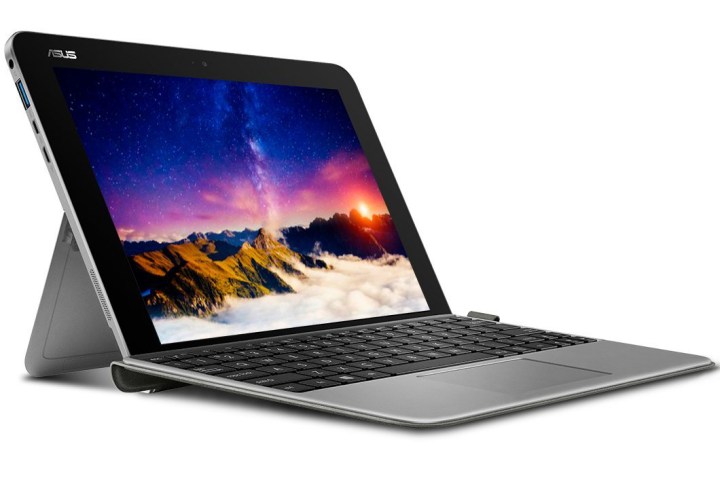
The B&H listing does not provide any specs, but Amazon’s listing is full of information regarding the T102HA-D4-GR model. Amazon currently describes it as the Transformer Book although the product number points to the upcoming Transformer Mini. As the current Asus portfolio seems to suggest, the Transformer Mini replaces the older Transformer Book (T101HA) product.
Here is what is packed inside:
| Processor: | Intel “Cherry Trail” Atom x5-Z8300 (quad-core) |
| Processor speed: | 1.44GHz base, 1.84GHz burst |
| System memory: | 4GB |
| Internal storage: | 128GB SSD |
| Screen size: | 10.1 inches |
| Screen resolution: | 1,280 x 800 |
| Wireless connectivity: | Wireless AC, Bluetooth 4.1 |
| Webcam | 2MP |
| Size: | 6.7 x 10.2 x 0.5 inches |
| Battery: | Up to 11 hours of video playback |
| Ports: | 1x USB 3.0 1x micro USB 1x mico HDMI 1x micro SD card reader 1x 3.5mm headphone jack |
According to the listing, the Transformer Mini features a magnesium alloy body, enabling a lightweight form factor of less than 1.7 pounds. It comes with a keyboard and pen, thus it measures only 0.6 inches thin with the larger peripheral attached and closed. It even packs a fingerprint reader that supports the Windows Hello feature in Windows 10. This device uses the Pro version of Microsoft’s operating system, so expect some installed bloatware from Asus.
The official product page shows that the Transformer Mini will be served up in Quartz Gray, Amber, Mint Green, and Icicle Gold colors. There will also eventually be a cheaper model providing only 64GB of internal storage. The website even states “up to 4GB” of system memory, meaning a version with a lower memory capacity could be possible for customers on a budget.
What is surprising here is the use of the Atom x5-Z8300 processor, which launched in the second quarter of 2015. That was over a year ago and a more updated version would be the x5-Z8330 processor launched in the first quarter of 2016. Asus is undoubtedly trying to keep the overall cost low by using the older chip. Check out the comparison:
| x5-Z8300 | X5-Z8330 | x5-Z8500 | |
| Launch data | Q2’15 | Q1’16 | Q1’15 |
| Process node | 14nm | 14nm | 14nm |
| Cores/Threads | 4/4 | 4/4 | 4/4 |
| Base clock speed | 1.44GHz | 1.44GHz | 1.44GHz |
| Burst clock speed | 1.84GHz | 1.92GHz | 2.24GHz |
| Cache | 2MB | 2MB | 2MB |
| Scenario design power | 2 watts | 2 watts | 2 watts |
| Max memory support | 2GB | 2GB | 8GB |
| Memory types | DDR3L-RS 1,600 | DDR3L-RS 1,600 | LPDDR3 1,600 |
| Max # of memory channels | 1 | 1 | 2 |
| Max memory bandwidth | 12.8GB/s | 12.8GB/s | 25.6GB/s |
| Integrated graphics | Intel HD Graphics | Intel HD Graphics 400 | Intel HD Graphics |
| Graphics base speed | 200MHz | 200MHz | 200MHz |
| Graphics burst speed | 500MHz | 500MHz | 600MHz |
| Max resolution | 1,920 x 1,080 | Not listed | 2,560 x 1,600 |
As the chart shows, there is not a lot of difference between the x5-Z8300 and the X5-Z8330, save for a slight increase in processor burst speed. That may be why Asus stuck with the older, cheaper chip in its new Transformer Mini device.
Also notice that we included the Intel Atom x5-Z8500 processor in the chart. That is what is packed in the Transformer Book T100HA model released in 2015. You can grab one of these for $270 that includes 4GB of system memory and 64GB of internal storage. You may get better performance out of the processor, but receive less storage space than the Transformer Mini in return.
Editors' Recommendations
- Apple Mac Mini M2 vs. M1: don’t make a buying mistake
- Pre-order glitch suggests Google Pixel Buds 2 will be here soon


